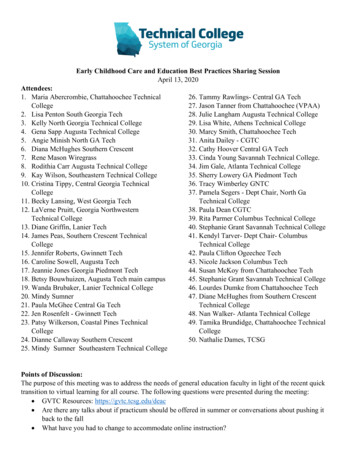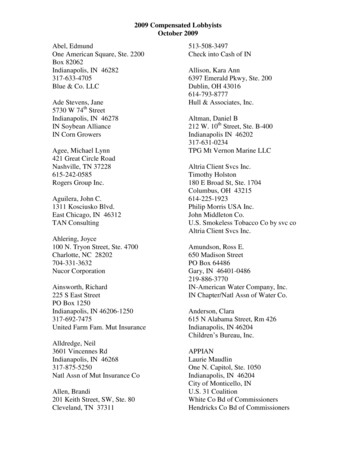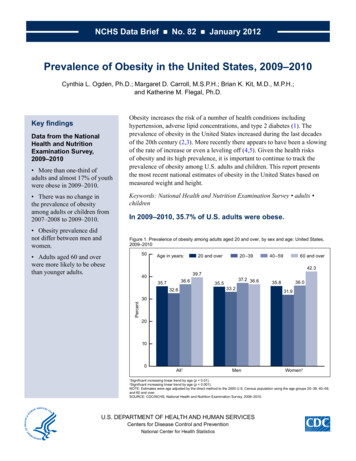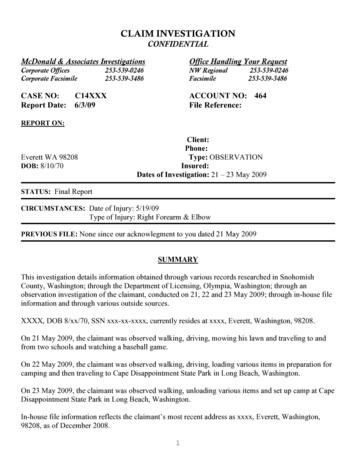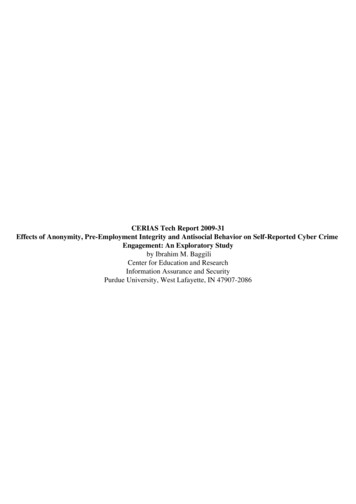
Transcription
CERIAS Tech Report 2009-31Effects of Anonymity, Pre-Employment Integrity and Antisocial Behavior on Self-Reported Cyber CrimeEngagement: An Exploratory Studyby Ibrahim M. BaggiliCenter for Education and ResearchInformation Assurance and SecurityPurdue University, West Lafayette, IN 47907-2086
Graduate School ETD Form 9(Revised 12/07)PURDUE UNIVERSITYGRADUATE SCHOOLThesis/Dissertation AcceptanceThis is to certify that the thesis/dissertation preparedBy Ibrahim BaggiliEntitled EFFECTS OF ANONYMITY, PRE-EMPLOYMENT INTEGRITY AND ANTISOCIALBEHAVIOR ON SELF-REPORTED CYBER CRIME ENGAGEMENT: ANEXPLORATORY STUDYFor the degree of Doctor of PhilosophyIs approved by the final examining committee:Marcus RogersChairWilliam GrazianoThomas HackerRichard MislanTo the best of my knowledge and as understood by the student in the Research Integrity andCopyright Disclaimer (Graduate School Form 20), this thesis/dissertation adheres to the provisions ofPurdue University’s “Policy on Integrity in Research” and the use of copyrighted material.Marcus RogersApproved by Major Professor(s):Approved by:Gary R. BertolineHead of the Graduate ProgramJuly, 12, 2009Date
Graduate School Form 20(Revised 6/09)PURDUE UNIVERSITYGRADUATE SCHOOLResearch Integrity and Copyright DisclaimerTitle of Thesis/Dissertation:Effects of Anonymity, pre-employment integrity and antisocial behvaior on selfreported cyber crime engagement: An exploratory studyDoctor of PhilosophyFor the degree ofI certify that in the preparation of this thesis, I have observed the provisions of Purdue UniversityExecutive Memorandum No. C-22, September 6, 1991, Policy on Integrity in Research.*Further, I certify that this work is free of plagiarism and all materials appearing in thisthesis/dissertation have been properly quoted and attributed.I certify that all copyrighted material incorporated into this thesis/dissertation is in compliance withthe United States’ copyright law and that I have received written permission from the copyrightowners for my use of their work, which is beyond the scope of the law. I agree to indemnify and saveharmless Purdue University from any and all claims that may be asserted or that may arise from anycopyright violation.Ibrahim BaggiliPrinted Name and Signature of CandidateJuly, 12, 2009Date (month/day/year)*Located at http://www.purdue.edu/policies/pages/teach res outreach/c 22.html
EFFECTS OF ANONYMITY, PRE-EMPLOYMENT INTEGRITY AND ANTISOCIALBEHAVIOR ON SELF-REPORTED CYBER CRIME ENGAGEMENT: ANEXPLORATORY STUDYA DissertationSubmitted to the FacultyofPurdue UniversitybyIbrahim M. BaggiliIn Partial Fulfillment of theRequirements for the DegreeofDoctor of PhilosophyAugust 2009Purdue UniversityWest Lafayette, Indiana
iiTo my father.
iiiACKNOWLEDGEMENTSI would like to thank everyone for their support. I especially want to thank my father forsupporting me, teaching me to never give up, and pursue my dreams. My father has been,and always will be my inspiration. I would also like to thank my committee members.Professor Marcus Rogers, thank you for allowing me to mature my research abilities atmy own pace, for always helping me, and continuously believing in me as a futureacademic colleague. Dr. Graziano, the same goes to you. You have inspired my interest insocial psychology, and I learned so much from your extensive experience and advice.Your interest and support has motivated me to pursue new learning opportunities in theinteresting world of social psychology. Professor Mislan, my thanks goes to you forhelping me understand mobile devices and the need to study them. I would especially liketo thank you for giving me the opportunity to be a guest speaker at your conference.Finally, I would have never been able to make it without the support of my loved onesand family members – all of you. To my wife, Meghan, thank you for being patientthrough our financial hardships while I pursued my dream of becoming Dr. Abe. Thankyou all for inspiring me, and letting me grow and achieve a goal that I’ve always dreamedof achieving. The funny thing is that, now that I have earned my PhD, I feel that my thirstto knowledge has just begun.
ivTABLE OF CONTENTSPageLIST OF TABLES . viiLIST OF FIGURES. viiiABSTRACT. ixCHAPTER 1 - INTRODUCTION . 1Statement of the problem . 1Purpose of the study. 4Research questions. 4Significance of the study. 5CHAPTER 2 – REVIEW OF LITERATURE . 6Cyber crime: what is it? . 8Anonymity. 15Anonymity & deindividuation . 19Anonymity and its research levels . 27Anonymity at the individual level. 27Anonymity at the group level. 28Anonymity and computer mediated communication . 30Pre-employment integrity tests– one way of decreasing cyber crime . 34Integrity. 34Integrity by self-integration. 35Integrity by commitment. 35Integrity as standing for something. 36Integrity as moral purpose. 36Integrity as a virtue. 37Discussion . 37Integrity Tests. 37Historical overview of integrity tests . 38Antisocial behavior . 41Operationalization of antisocial behavior . 43Tying it all together. 45Summary . 51
vPageCHAPTER 3 - METHODOLOGY . 53Constructs . 54Self-reported antisocial behavior . 55Self-reported pre-employment integrity. 55Anonymity. 55Self reported cyber crime . 56Research protocol. 57Participants. 57Study protocol . 59Anonymity manipulation . 60Construct validity and reliability. 63Construct validity. 63External validity & face validity . 64Reliability. 64Data analysis . 65CHAPTER 4 – RESULTS . 66Descriptive statistics . 66Exploratory data analysis for all cases . 67Exploratory data analysis for control group (Group 1) . 72Exploratory data analysis for computer group (Group 2) . 75Exploratory data analysis for ID group (Group 3) . 78Possible moderation . 82Discussion of exploratory data analysis . 83Hypotheses analyses. 84Hypothesis 1. 84Hypothesis 2. 86Hypothesis 3. 87Hypothesis 4. 88Hypotheses 5 and 6 . 88Hypotheses 7 and 8 . 90Hypothesis 9. 92CHAPTER 5 – DISCUSSIONS AND CONCLUSIONS . 94Summary of findings. 94Hypotheses discussion . 95Hypothesis 1. 95Hypothesis 2. 97Hypothesis 3. 98Hypothesis 4. 98Hypothesis 5 & Hypothesis 6. 99Hypothesis 7 & Hypothesis 8. 99Hypothesis 9. 100Limitations . 101Implications for future research . 102
viPageContribution of the study . 103Conclusions. 104REFERENCES . 106APPENDICESAppendix A – Control Survey . 121Appendix B – Computer Group Sruvey. 125Appendix C – ID Group Survey. 130Appendix D – Consent and Post Consent Forms. 135VITA . 137
viiLIST OF TABLESTablePageTable 1. Anonymity and the deindividuation theories . 48Table 2. Zero ordered correlation . 64Table 3. The Reliability of the Pre-employment Integrity Measure . 65Table 4. The Reliability of the Cyber Crime Engagement Measure . 65Table 5. The Reliability of the Antisocial Behavior Measure . 65Table 6. Levene’s Test . 67Table 7. Descriptive Statistics for all cases . 68Table 8. Descriptive Statistics for Control Group . 73Table 9. Q-Q Plots for Control Group . 74Table 10. Box Plots for Control Group. 75Table 11. Descriptive Statistics for Computer Group. 76Table 12. Q-Q Plots for Computer Group . 77Table 13. Box Plots for Computer Group. 78Table 14. Descriptive Statistics for ID Group. 79Table 15. Q-Q Plots for ID Group . 80Table 16. Box Plots for ID Group. 81Table 17. Descriptive Statistics. 84Table 18. ANOVA Results . 85Table 19. Tukey's Test . 86Table 20. Correlation ASB and CCI . 87Table 21. CCI and PPI Correlation . 87Table 22. PPI and ASB Correlation . 88Table 23. GLM Results (Antisocial behavior x Anonymity). 89Table 24. GLM Results (Pre-employment integrity x Anonymity) . 91Table 25. GLM Results (Pre-employment integrity x Antisocial behavior x Anonymity)92
viiiLIST OF FIGURESFigurePageFigure 1. Hierarchical structure of different anonymity conditions . 17Figure 2. Theory Diagram . 54Figure 3. Participants by Age . 57Figure 4. Participants by Major . 58Figure 5. First page of survey. 61Figure 6. Computer Group . 61Figure 7. Anonymity Manipulation Form . 62Figure 8. ID Manipulation . 63Figure 9. Q-Q Plot for cyber crime engagement . 69Figure 10. Q-Q Plot for antisocial behavior . 70Figure 11. Q-Q Plot for pre-employment integrity. 70Figure 12. Box Plot for cyber crime engagement. 71Figure 13. Box Plot for antisocial behavior. 71Figure 14. Box Plot for pre-employment integrity . 72
ixABSTRACTBaggili, Ibrahim M. Ph.D. Purdue University, August 2009. Effects of anonymity, selfreported pre-employment integrity and self-reported antisocial behavior on self-reportedcyber crime engagement: An exploratory study. Major Professor: Marcus Rogers.A key issue facing today’s society is the increase in cyber crimes. Cyber crimes posethreats to nations, organizations and individuals across the globe. Much of the research incyber crime has risen from computer science-centric programs and little experimentalresearch has been performed on the psychology of cyber crime. This has caused aknowledge gap in the study of cyber crime. To this end, this dissertation focuses onunderstanding psychological concepts related to cyber crime. Through an experimentaldesign, participants were randomly assigned to three groups with varying degrees ofanonymity. After each treatment, participants were asked to self-report their cyber crimeengagement, antisocial behavior and pre-employment integrity. Results indicated that theanonymity manipulation had a main effect on self-reported cyber crime engagement. Theresults also showed that there is a statistically significant positive relationship betweenself-reported antisocial behaviors and cyber crime engagement, and a statisticallysignificant negative relationship between self-reported cyber crime engagement and preemployment integrity. Suggestions for future research are also discussed.
1CHAPTER 1 - INTRODUCTIONStatement of the problemCyber crime is an unlawful act in which a computer/s is/are used as means ofcommitting a crime against a person, property or the government (Babu & Parishat,2004). Sukhai (2004) explained that an FBI and Computer Security Institute annualsurvey of 520 companies and institutions reported more than 60% unauthorized use ofdigital computer systems during a period of 12 months and 57% of all break-ins involvedthe Internet. Even though these numbers seem large, Sukhai (2004) describes that about60% of cyber attacks are not even detected. Research indicates that only about 15% ofexposed attacks are reported to law enforcement agencies (Sukhai, 2004). In the newer2006 FBI and Computer Security Institute annual survey of 313 companies andinstitutions, it was found that the total losses attributed to security breaches amounted to 52,494,290 dollars (Gordon et al., 2006). Finally, in the 2008 CSI Computer Crime andSecurity Survey, it was noted that there is an average loss of 500,000 with corporationsexperiencing financial fraud (related to computing) and an extra average of 350,000 lossat companies that experienced “bot” attacks.The abovementioned figures illustrate that the capital losses attributed tounauthorized use of computers have a substantial damaging bearing on today’s economy.This is also reinforced in the significant average capital loss in the 2008 survey. Due to
2the negative impact of cyber crime on society, it becomes imperative to understand thesocial and psychological implications of the cyber crime phenomenon.Many researchers have focused their efforts on technical aspects related todecreasing cyber crime through computer technology/science prevention and incidentresponse techniques. Rogers (2003) explained that little psychological research isconducted on cyber crime focusing on factors such as personality traits/individualdifferences, motivation and situational factors associated with the cyber criminals. It isnow 2009 and this statement remains true. Two major questions whose answers willremain of important value in social scientific research on cyber crime still need to beexamined: What attracts people to cyber criminal activities? And what personalitytraits/individual differences are associated with cyber criminals?Literature suggests that one of the major reasons people are attracted to cybercrime is the anonymity they encounter in computer mediated environments (Lipson,2002; Williams, 2002). The literature further uncovered that experimental research onanonymity derived from Computer Mediated Communication (CMC) is used to explaincomputer communication and not computer crime. It is necessary to recognize that justbecause someone communicates via computers using technologies like e-mail and chatclients, doesn’t inevitably denote that the act of communication is unlawful and criminal.Therefore, anonymity needs to be extended from CMC research to cyber criminalresearch.Lastly, the seminal psychological studies on cyber crime do not exploreanonymity as a situational factor in their experimental procedures (Rogers 1999; Rogers,
32001; Rogers, 2003, Shaw et. al, 1998). Manipulating anonymity in the experimentalprocedures may shed some light on situational factors that affect the relationship betweenpersonality traits/individual differences and cyber crime engagement.As for the personality traits of cyber criminals, there still remains a plethora ofpersonality constructs that need to be examined. For instance, the influential literature onIT insider threat by Shaw et al. (1998) concluded that pre-employment integrity screeningshould be performed to decrease cyber crimes arising from within an organization. Due tothe Shaw et al. (1998) concluding remarks, this dissertation builds on their work andexamines the relationship between cyber criminal activities and an individual’soperationalized pre-employment integrity.Lastly, research in the pre-computer era has concluded that anonymity inducesindividuals to engage in antisocial behaviors (Diener, 1979; Zimbardo, 1969). Researchin CMC has also indicated that as the level of anonymity increases, individuals are morelikely to portray antisocial/disinhibitive behaviors (Tresca, 1998). However, theseconclusions have not been validated in the context of cyber criminals. It then becomesnecessary to test if our current understanding of antisocial behavior in psychology can berelated to cyber criminals. This test may lead to future research aimed at the creation ofnew antisocial self-reported measures that are predictive of cyber criminals.
4Purpose of the studyThe purpose of the study is to investigate how cyber crime engagement is relatedto integrity, anonymity and self-reported antisocial behaviors.Research questionsThis research aims to answer the following questions:Q1: Does manipulating someone’s anonymity affect their self-reported cyber crimeengagement?Q2: Is there a significant relationship between the self-reported antisocial behavior andself-reported cyber crime engagement?Q3: Is there a significant relationship between self-reported pre-employment integrity andself-reported cyber crime engagement?Q4: Does anonymity significantly affect the relationship between self-reported preemployment integrity and self-reported cyber criminal engagement?Q5: Does anonymity significantly affect the relationship between self-reported antisocialbehaviors and self-reported cyber criminal engagement?Q6: Can self-reported antisocial behavior and pre-employment integrity significantlypredict cyber criminal engagement?Q7: Are there any interactions between any of the self-reported measures (antisocialbehaviors, cyber crime engagement and pre-employment integrity)?
5Significance of the studyThis research builds on the research conducted in other psychological studies byRogers et al. (2006) and Shaw et al. (1998). Primarily, this research makes a contributionto the experimental literature on the psychology of cyber criminals by extending previouswork on integrity and antisocial behavior. Another notable contribution of this research isthe insight it offers into accounting for anonymity when performing psychologicalresearch related to cyber crime. It may also have dramatic implications on helpingresearchers understand if the traditional operationalizations of antisocial behavior andpre-employment integrity can be associated with cyber criminals. The study will also helpin testing if traditional pre-employment integrity screening tests may potentially be usedto predict computer criminals. Lastly, the results obtained from this research may inspirefuture research in this area for novel ways of measuring and manipulating anonymity.
6CHAPTER 2 – REVIEW OF LITERATUREThe dependency of humans on Information Technology (IT) and the Internet hasdramatically increased. Seldom do we see individuals not using a technological devicelike a cellular phone, a laptop computer or an iPod. IT has penetrated our lives and hashad some noticeable implications on our society. The Internet, for instance, has becomedomesticated and is now used by the majority of Americans for personal and economicreasons (Cummings & Kraut, 2002). One can provide an endless list of statistics onInternet usage and IT released by the U.S. Department of Commerce and other sources,but the impact of technology on humans has become quite obvious.In the past, humans believed that technology and humans belonged in twodifferent distinct worlds (Saariluoma, 2007). Saarriluoma (2007), the editor in chief of thejournal on humans in ICT environments called Human Technology points out a famousbook written by C.P Snow (1959) called The two cultures and the scientific revolution,where Snow (1959) argues that the social and technical disciplines of technology areseparated by a high wall. He also argues that in today’s world, copious amount ofresearch has indicated that technology is influenced by humanistic ideals. Thesedeclarations reveal an interaction of humans with technology, and technology withhumans. To better understand the relationship between humans and technology, researchneeds to be conducted in this area.
7A great deal of the research being performed in computing has focused on thepositive aspects of human computer interaction. For instance, research on the positiveimpact of human interaction via electronic mail and chatting has been prominent on theagendas of social and psychological researchers. Research like this has had a constructiveinfluence on our understanding of how and why humans interact electronically. However,paralleling the notion of positive computer use is computer misuse. The drastic increasein the misuse of electronic devices has led toward the cyber crime phenomenon.There is plenty of speculation of why cyber crime was, and still is on the rise inour society. Literature in CMC has shown that one of the prominent situational factorsaffecting the electronic interaction of people is anonymity. Research on anonymity hasillustrated that the increase in anonymity induces people’s engagement indisinhibitive/antisocial behaviors (Diener, 1979; Tresca, 1998; Zimbardo, 1969). Otherresearch in the psychology of cyber criminals has shown that they are more likely toposses certain personality traits, one of which may be the level of personal integrity(Shaw et al., 1998). The following literature review aims to bring the reader up to pace onthe writings and research associated with these concepts. First, the concept of cyber crimewill be discussed and limited to white collar crime and IT insider threat. Next, theliterature on anonymity will be reviewed. Lastly, literature on pre-employment integrityand antisocial behavior will be reviewed.
8Cyber crime: what is it?Cyber crime is an unlawful act in which a computer/s is/are used as means ofcommitting a crime against a person, property or the government (Babu & Parishat,2004). In the California review of law, Brenner (2000) illustrates that according to howthe law defines crime,
conducted on cyber crime focusing on factors such as personality traits/individual differences, motivation and situational factors associated with the cyber criminals. It is now 2009 and this statement remains true. Two major questions whose answers will remain of important value in social scientific research on cyber crime still need to be


